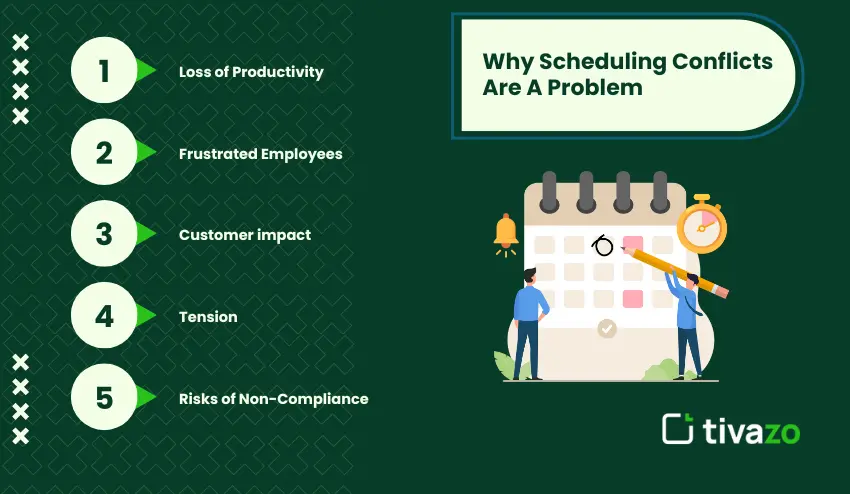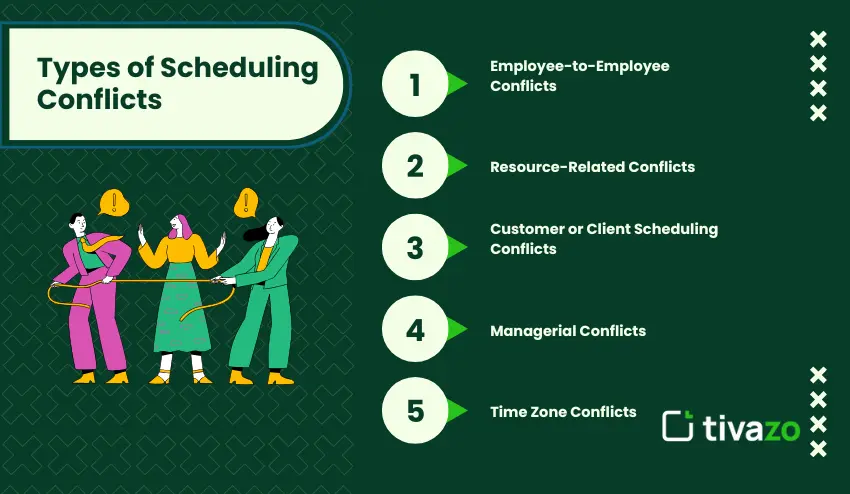You have likely been in a situation where two important meetings were scheduled simultaneously, or a shift change that went unnoticed until the last minute. These minor errors have the potential to balloon into missed deadlines, irritated employees, and lost productivity.
Conflicts in the schedule can seem like a small inconvenience, but it is one of the biggest unseen costs to efficiency in the workplace. They interfere with teamwork, lead to stress and in worst-case scenarios, customer satisfaction. In the case of growing teams, such clashes are not only a bonus to avoid, but a necessity.
In this guide, we will explain what scheduling conflicts are, how and why they occur, and most importantly how to prevent and manage them. As a manager who wants to streamline operations or an employee who wants to balance schedules, you will find practical strategies here to keep schedules running smoothly.
What Are Scheduling Conflicts?
A scheduling conflict occurs when two or more tasks, meetings, or shifts are scheduled simultaneously in a manner that does not allow one to attend or complete them successfully. These conflicts may be as trivial as scheduling the same meeting room at the same time or as complicated as scheduling employees in conflicting shifts without enough employees to cover.
In the workplace, scheduling conflicts show up in different ways:
- Overlapping meetings with members of the team being required in more than one place at a time.
- Shift conflicts in which employees are assigned at the same time leaving other periods unattended.
- Resource conflicts like reserving the same equipment or space to be used by more than one project.
- Time zone problems when remote teams get out of synch with availability.
The key to preventing scheduling conflicts is to understand what they look like. When you are able to spot such conflicts, then it becomes simpler to create systems and policies that will keep everyone in the right track.
Why Scheduling Conflicts Are A Problem
Scheduling conflicts may seem insignificant at first, but they may lead to bigger problems unless dealt with effectively. Even a single case of a meeting being booked twice can cause the productivity to be disrupted, and frequent conflicts can affect morale, performance, and even customer satisfaction.

The following are reasons why it is important to address them:
- Loss of Productivity- Employees waste time in trying to reschedule or trying to juggle conflicting schedules.
- Frustrated Employees- They tend to have scheduling problems that can make them feel underappreciated and even neglected. This will disrupt productivity, morale, and might also result in work overload.
- Customer impact-In the health industry, retail, or hospitality industries, customer service is directly impacted by scheduling errors.
- Tension- When certain individuals are favored in terms of their time, other team members may develop resentment and team conflict.
- Risks of Non-Compliance- In certain workplaces, the failure to schedule properly may contravene labor laws, including failure to provide rest between shifts.
When not managed, such conflicts not only cause a delay in schedules, but also create mistrust, lack of cooperation and the performance of the business.
Common Causes of Scheduling Conflicts
Scheduling conflicts are usually a combination of human error, poor planning and lack of proper tools. Knowing the root causes enables one to prevent them more easily.
Here are the most common reasons conflicts occur:
- Double-Booking -Allocation of a resource or a person to two activities or meetings simultaneously.
- Last-Minute Changes – Last-minute cancellations or rescheduling of events cause havoc to well-thought-out schedules.
- Lack of Visibility – Team members cannot see the availability of others and this causes overlaps.
- Overlapping Priorities – When two managers are demanding the time of the same employee, it creates conflict that cannot be avoided.
- Time Zones – Working in international teams, it is easy to forget about time zone differences and miss or conflict meetings.
- Ineffective Communication- Without clear communication of updates, people can be seen to stick to old schedules.
By knowing these causes, teams will be able to implement systems to avoid scheduling headaches before they get out of hand.
Types of Scheduling Conflicts
Not every scheduling conflict is identical Others are minor inconveniences but others can kill projects and ruin customer relations. These are the key types:

- Employee-to-Employee Conflicts
When two or more employees are assigned to the same time to work overlapping shifts or meetings. This is common when schedules are being made without a cross-check of availability. - Resource-Related Conflicts
Such resources as meeting rooms, equipment, or company vehicles can be booked twice without the proper tracking. This form of conflict slows down work and irritates workers. - Customer or Client Scheduling Conflicts
In job functions that are service oriented, conflicting appointment with the customers may result to poor experiences, missed deadlines or even loss of business. - Managerial Conflicts
Employees also get conflicting priorities by different managers. This leaves them with the choice of which task to address first, which causes friction and delays. - Time Zone Conflicts
In remote or global teams, cross-time zone scheduling may lead to meetings at unreasonable times or inadvertent duplication.
Once these types are identified, it is easier to map solutions to the problem.
The Impact of Scheduling Conflicts
Scheduling conflicts appear to be a minor issue but the impacts are far-reaching and expensive. The effects that they produce on the employees and the organizations are as follows:
- Lost Productivity
A conflict in schedules or two or more meetings overlapping wastes a lot of time in rescheduling. This slows the pace of production and output. - Employee Stress and Burnout
Frequent changes in schedules or conflicts may be unpleasing to the employees causing them stress, demotivation, and high turnover. - Customer Dissatisfaction
Late appointments or understaffed shifts may kill the relationships with the customers, which can lead to complaints or even lost clients. - Increased Labor Costs
The resolution to the conflicts can be attributed to overtime, last-minute substitutes, or overstaffing, which raises the payroll costs. - Strained Team Collaboration
Individuals cannot be found at critical times and this has an impact on teamwork. Projects are longer to finish, communication breaks down and schedules are extended.
In brief, scheduling issues that remain unresolved may negatively affect the productivity, profitability and the health of the employees and therefore, should be addressed beforehand.
How to Avoid Scheduling Conflicts
Preventing scheduling conflicts is not only about filling out calendars, but also about establishing systems that suit both the employer and the employee. The following are tested methods that make the scheduling process easier and less stressful:
1. Central Scheduling Tools
Instead of communicating via emails or spreadsheets, a shared scheduling platform should be used. Availability may be viewed in real-time by using software like Google Calendar, Outlook or workforce management software. This minimizes the possibility of over-booking and rectifies corrections faster.
2. Clarify Policies on Greater Scheduling
Employees should know the period they are supposed to make time off requests, shift swap, and report conflicts in advance. Clearly defined rules help to remove confusion and help managers to make fair decisions when there are conflicts in availability.
3. Facilitate Free Communication
Conflicts are likely to arise as a result of failure of the employees to express concerns. The team members should be encouraged to bring up scheduling problems as soon as possible. A brief discussion will save last minute panic.
4. Monitor Workloads and Overtime
In other instances, the conflicts are not only associated with overlapping shifts but also with overworking some staff. Monitor workloads, overtime and time off balances to ensure that they are apportioned fairly.
5. Book in Advance to Prevent Crowds
Retailers, healthcare facilities, and service-based businesses are usually busy. Planning in advance (weeks or even months) will reduce the possibility of any last minute conflicts.
6. Back Up Options
Cross-train train employees to ensure that you have a backup staff that can fill in whenever there is a conflict. This is flexible and scheduling is less hectic to everybody.
Best Practices for Resolving Scheduling Conflicts
Even though planning is done, there can be scheduling conflicts. The best approach to take with them is to make sure that productivity is not lost and that employee morale is not compromised. These are best practices:
1. Resolve Address Conflicts Quickly
The quicker a conflict is identified, the less difficult it is to resolve. Train the workers to report overlaps as early as they notice them instead of letting it be until the shifts or deadlines are missed.
2. Involve the Employees in the Solution
Give employees the opportunity to propose a solution, e.g. swapping shifts or deadlines. This is a group effort which is less frustrating and more of a buy-in.
3. Highlight Equity and Equity
Use the same criteria in determining whose schedule is more important than another one (seniority, project deadlines, workload). Avoid favoritism in order to maintain trust and fairness.
4. Document Adjustments
Keep a clear record of change of schedules. Putting agreements, approvals, or exceptions on paper will help prevent misunderstanding and can serve as a reference point in the event of any future conflict.
5. Trends of Future Enhancement
After solving conflicts, assess the causes of them. By identifying recurring issues, managers can modify their scheduling policies or introduce better tools to prevent the same issues in the future.
Scheduling Conflicts in Remote & Hybrid Work
Remote and hybrid work arrangements present new problems in terms of scheduling. Even teams that communicate effectively face-to-face may experience a conflict when working in different locations or time zone.

1. Time Zone Problems
The team members in various regions may share working hours that are restricted or absent. Meetings may be scheduled at inconvenient times, which frustrates and causes poor attendance without some careful planning. This might lead to remote conflict.
2. Overlapping Virtual Meetings
Video calls one after another or virtual meetings at the same time can cause conflicts and exhaustion. Employees will have difficulties attending more than one meeting or submitting tasks on schedule.
3. Flexible Work Hours
Although the flexibility is a plus, it may create conflicts without proper communication of availability. Managers should monitor the time when employees are working to prevent conflicts.
4. Solutions for Remote Teams
- Use standard calendars with automatic time zone setting.
- Hold frequent meetings at the overlapping core hours
- Encourage team members to update availability on a regular basis.
- Use scheduling software which has conflict notification so as to eliminate scheduling conflicts.
By planning these issues in advance, remote and hybrid teams can remain productive and reduce stress due to scheduling issues.
Tools to Manage Scheduling Conflicts
By having the correct tools, scheduling conflicts can be minimized significantly and planning can become much easier even with teams of any size. The most effective types are the following ones:
1. Calendar and Scheduling Software
- Google Calendar / Outlook: This is a good option to have a simple scheduling tool with shared access and conflict notification.
- Calendly / Doodle: comes in handy when organizing meetings without the emails back and forth.
2. Workforce Management Tools
- When I Work / Deputy / Homebase: These tools are specifically tailored towards shift-based workforces, and allow you to track employee availability, assign shifts, and to prevent overlaps.
3. Project Management Platforms
- Asana / Trello / Monday.com: They do not focus on scheduling but allow seeing the deadlines of the tasks and the availability of the team members, so that conflicts can be avoided. Using a project management tool can help and resolve the issues.
4. Time Zone and Global Team Tools
- World Time Buddy / Every Time Zone: Making it easier to schedule events across geographies and eliminate mistakes that can be made when trying to calculate time zones.
Key Benefits of Using Tools
- Avoid overlapping of meetings and missed appointments.
- Enhance inter-team transparency
- Minimize on administrative overheads
- Give warnings and reminders of conflicts to come.
When the right software is combined with clear policies, teams will be able to avoid most scheduling conflicts before they occur and address them effectively when they do.
Common Mistakes to Avoid with Scheduling
Even with the policies and tools in place, scheduling conflicts are a common occurrence and they are the result of some preventable errors. This is what to watch out:
1. Ignoring Availability of Employees
Failure to consider the desired working hours of team members, their personal obligations, and time zones might lead to numerous conflicts and frustrations.
2. Overloading Key Employees
When a small number of people are assigned to do a lot of work or meetings, this can create a bottleneck and can result in overlaps.
3. Lack of Centralized Scheduling
When various platforms, spreadsheets, and emails are used, the conflict is more probable to arise and harder to resolve since there is no single source of truth.
4. Failing to Communicate Changes
Last minute changes in meeting or shifts without proper notification can lead to disorientation and employees can end up running around.
5. Not Reviewing Patterns
The inability to resolve the recurrent scheduling problems will not result in long-term solutions. Periodic review helps to highlight trends and to make corrections.
These pitfalls can be avoided to ensure that schedules will not be disrupted, employees will continue to be productive and conflicts will not blow out of proportion.
Conclusion
One of the most common problems of the contemporary and hybrid workplace is scheduling conflicts. Otherwise, they can disrupt productivity, demoralize employees and hurt team morale.
Most scheduling conflicts can be prevented with the right knowledge of the varieties and causes of scheduling conflicts, the right tools and clear policies. The rapid solution mechanisms and timely reviews ensure that overlaps which are unavoidable are dealt with in a smooth way.
No matter whether you work with in-person, remote, or hybrid teams, proactive scheduling practices will help you to ensure the work process goes much smoother, your employees are happier, and your business more successful.




